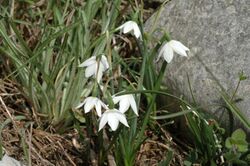Biology:Acis nicaeensis
| Acis nicaeensis | |
|---|---|

| |
| Scientific classification | |
| Kingdom: | Plantae |
| Clade: | Tracheophytes |
| Clade: | Angiosperms |
| Clade: | Monocots |
| Order: | Asparagales |
| Family: | Amaryllidaceae |
| Subfamily: | Amaryllidoideae |
| Genus: | Acis |
| Species: | A. nicaeensis
|
| Binomial name | |
| Acis nicaeensis (Ardoino) Lledó, A.P.Davis & M.B.Crespo[1]
| |
| Synonyms[1] | |
| |
Acis nicaeensis, sometimes called the French snowflake,[2] is a species of flowering plant in the family Amaryllidaceae, native to south-eastern France.[1] A small spring flowering bulb with white flowers, it is cultivated as an ornamental plant.
Description
Acis nicaeensis is a bulbous perennial, growing up to 18 cm tall, although often less. It generally has a tufted growth habit, with thin leaves appearing before the flowers. The flowers have white tepals, 8–12 mm long with sharply pointed tips. There is usually only one flower per flowering stem (peduncle), although there can be up to three. The flower stalks (pedicels) are 10–18 mm long. The style is just longer than the stamens. The six-lobed ovary is disc-shaped.[2][3]
Taxonomy
Acis nicaeensis was first described in 1867 by Honoré Ardoino, as Leucojum nicaeensis.[1] The specific epithet nicaeensis refers to Nice, in south-east France.[4] In 2004, it was transferred to Acis, along with other species of Leucojum, on the basis of a molecular phylogenetic study.[5]
Distribution and habitat
Acis nicaeensis is native to the Maritime Alps and neighbouring coast of south-eastern France (including Monaco), where it is found on rocky hillsides.[2][3]
Cultivation
Acis nicaensis is grown as an ornamental spring flowering bulb. It is hardy to frost if planted in a sheltered and sunny position, although often grown in an alpine house or bulb frame.[3]
References
- ↑ 1.0 1.1 1.2 1.3 "Acis nicaeensis", World Checklist of Selected Plant Families (Royal Botanic Gardens, Kew), http://apps.kew.org/wcsp/namedetail.do?name_id=309233, retrieved 2017-11-30
- ↑ 2.0 2.1 2.2 Grey-Wilson, Christopher; Mathew, Brian & Blamey, Marjorie (1981), Bulbs : the bulbous plants of Europe and their allies, London: Collins, ISBN 978-0-00-219211-8, p. 136 (as Leucoium longifolium)
- ↑ 3.0 3.1 3.2 Mathew, Brian (1987), The Smaller Bulbs, London: B.T. Batsford, ISBN 978-0-7134-4922-8, p. 120 (as Leucojum longifolium)
- ↑ Stearn, W.T. (2004), Botanical Latin (4th (p/b) ed.), Portland, Oregon: Timber Press, ISBN 978-0-7153-1643-6
- ↑ Lledó, Ma D.; Davis, A.P.; Crespo, M.B.; Chase, M.W. & Fay, M.F. (2004), "Phylogenetic analysis of Leucojum and Galanthus (Amaryllidaceae) based on plastid matK and nuclear ribosomal spacer (ITS) DNA sequences and morphology", Plant Systematics and Evolution 246 (3-4): 223–243, doi:10.1007/s00606-004-0152-0, https://www.researchgate.net/profile/Manuel_Crespo4/publication/226774240_Phylogenetic_analysis_of_Leucojum_and_Galanthus_Amaryllidaceae_based_on_plastid_matK_and_nuclear_ribosomal_spacer_ITS_DNA_sequences_and_morphology_Plant_Systematics_and_Evolution/links/0912f5075582a056b5000000/Phylogenetic-analysis-of-Leucojum-and-Galanthus-Amaryllidaceae-based-on-plastid-matK-and-nuclear-ribosomal-spacer-ITS-DNA-sequences-and-morphology-Plant-Systematics-and-Evolution.pdf, retrieved 2017-12-04
Wikidata ☰ Q2885887 entry

